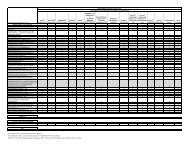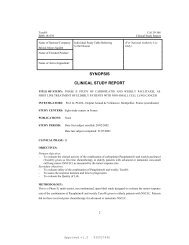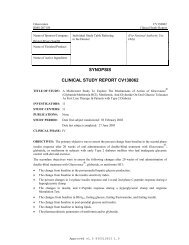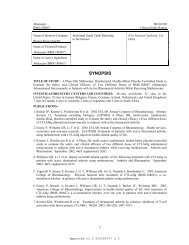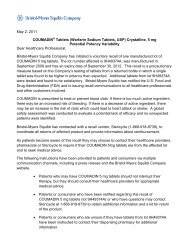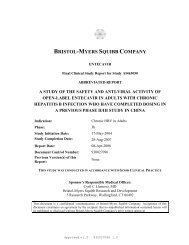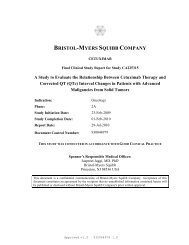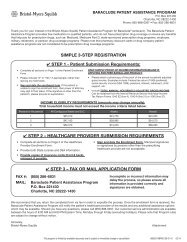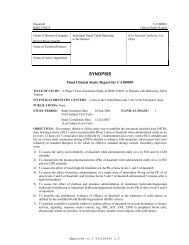SYNOPTIC STUDY REPORT - Clinical Trials - Bristol-Myers Squibb
SYNOPTIC STUDY REPORT - Clinical Trials - Bristol-Myers Squibb
SYNOPTIC STUDY REPORT - Clinical Trials - Bristol-Myers Squibb
Create successful ePaper yourself
Turn your PDF publications into a flip-book with our unique Google optimized e-Paper software.
Ixabepilone<br />
BMS-247550<br />
CA163012<br />
Synoptic Study Report<br />
<strong>SYNOPTIC</strong> <strong>STUDY</strong> <strong>REPORT</strong><br />
Name of Sponsor/Company:<br />
<strong>Bristol</strong>-<strong>Myers</strong> <strong>Squibb</strong><br />
Name of Finished Product:<br />
Not Available<br />
Name of Active Ingredient:<br />
Ixabepilone<br />
Individual Study Table Referring<br />
to the Dossier<br />
(For National Authority Use<br />
Only)<br />
TITLE OF <strong>STUDY</strong>: A Phase 2 Study of BMS-247550 in Patients with Metastatic Colorectal Cancer<br />
Previously Treated with a Fluoropyrimidine and Irinotecan<br />
INVESTIGATORS/<strong>STUDY</strong> CENTERS: Total Number of Investigators: 13 (6 in the United States, 4<br />
in France, and 3 in Germany)<br />
The name and location of each site is presented in Appendix A.<br />
PUBLICATIONS: None.<br />
<strong>STUDY</strong> PERIOD: Date first patient enrolled: 26-Feb-2001<br />
Date last patient completed: 05-Aug-2002<br />
CLINICAL PHASE: 2<br />
INTRODUCTION: This study investigated the safety and clinical activity of BMS-247550 (ixabepilone)<br />
in patients with metastatic colorectal cancer who had been previously treated with one prior regimen of<br />
fluoropyrimidine and irinotecan chemotherapy for metastatic disease. The modified Gehan’s design in this<br />
study required 19 response-evaluable patients for the first stage. After 21 patients had been enrolled at the<br />
original dose of 50 mg/m 2 infused over 1 hour every 21 days, the protocol was amended because of<br />
possible neurotoxicity at this dose. One partial response (PR) was observed with the 50 mg/m 2 dosing. The<br />
new dose was 6 mg/m 2 infused over 1 hour for 5 consecutive days every 21 days. Thirty-two patients were<br />
enrolled at this dose. The study was terminated because there were no responders during Stage 1 of the<br />
daily x 5 regimen and it was concluded that the drug was not efficacious in this tumor type. This synoptic<br />
report summarizes the key safety parameters for the 20 evaluable patients who received ixabepilone every<br />
21 days at 50 mg/m 2 and the 31 evaluable patients who received ixabepilone at 6 mg/m 2 for 5 consecutive<br />
days every 21 days. The pharmacokinetic data will be presented in a separate population pharmacokinetics<br />
report.<br />
OBJECTIVES:<br />
Primary Objective(s):<br />
To assess the clinical activity of ixabepilone, as measured by the tumor response rate in patients with<br />
metastatic colorectal cancer who had previously been treated with a fluoropyrimidine and irinotecan for<br />
metastatic disease, who were given ixabepilone as a 1 hour infusion daily for 5 consecutive days (Days<br />
1 - 5) every 21 days.<br />
Approved v2.0 930008512 2.0
Ixabepilone<br />
BMS-247550<br />
CA163012<br />
Synoptic Study Report<br />
Secondary Objectives:<br />
1) To evaluate the activity and safety of ixabepilone administered as a 1 hour infusion every 3 weeks in<br />
patients with metastatic colorectal cancer who had previously been treated with a fluoropyrimidine and<br />
irinotecan for metastatic disease;<br />
2) To evaluate the safety of ixabepilone administered as a 1-hour daily for 5 consecutive days (Days<br />
1 - 5) every 21 days in patients with metastatic colorectal cancer who had previously been treated with<br />
a fluoropyrimidine and irinotecan for metastatic disease;<br />
3) To assess the response duration, time to progression and survival of patients with metastatic colorectal<br />
cancer who had previously been treated with a fluoropyrimidine and irinotecan for metastatic disease,<br />
who were given ixabepilone as a 1 hour infusion for 5 consecutive days (Days 1 - 5) every 21 days;<br />
4) To provide ixabepilone plasma concentration versus time data for a future population pharmacokinetic<br />
evaluation of ixabepilone.<br />
METHODOLOGY: This was a Phase 2, multicenter, multinational, nonrandomized, single-arm, openlabel<br />
study of ixabepilone in patients with metastatic colorectal cancer. Patients must have received at least<br />
1 prior therapy with irinotecan and a fluoropyrimidine for metastatic disease. A modified Gehan’s design 1<br />
was used to test whether the objective response rate was of clinical interest. Ixabepilone was to be<br />
administered on Day 1 to Day 5 every 21 (consecutive) days at a dose of 6 mg/m²/day (as per amendment,<br />
the original protocol dosed patients at 50 mg/m 2 once every 3 weeks). Prior to ixabepilone administration,<br />
patients were premedicated with H 1 and H 2 blockers to prevent potential hypersensitivity reactions<br />
observed in prior studies due to the cremaphor in the formulation used. Patients were to be assessed at<br />
regular intervals during treatment. Six blood samples were to be collected during Cycle 1, on Day 5, for the<br />
measurement of ixabepilone plasma concentrations. The protocol, amendment, and administrative letters<br />
for study CA163012 are provided in Appendix B. A sample Case Report Form (CRF) is provided in<br />
Appendix C.<br />
NUMBER OF PATIENTS: In this study, patients were treated with ixabepilone either at a dose of<br />
50 mg/m 2 once every 21 days or 6 mg/m 2 /day for 5 days every 21 days.<br />
Ixabepilone 50 mg/m 2 q 21 days<br />
Twenty-one patients were enrolled to be treated with ixabepilone 50 mg/m 2 every 21 days (Supplemental<br />
Table S.1; Appendix 1). One patient (CA163012-6-605) never received treatment because the patient had<br />
surgery for Grade 4 colitis and the investigator decided not to start this patient on study drug. Three patients<br />
were deemed ineligible: 2 of these patients were granted exemptions (Supplemental Table S.3): patient<br />
CA163012-1-104 had a platelet count < 125,000 mm 3 and patient CA163012-2-202 had previous<br />
chemotherapy completed less than 4 weeks prior to enrollment; patient CA163012-2-203 had baseline<br />
ECOG of 2 which was out of the acceptable 0 - 1 range and was not granted an exemption (Appendix 3).<br />
One patient (CA163012-1-102) received irinotecan and fluorouracil that was characterized only as adjuvant<br />
therapy and not for metastatic disease; the patient was enrolled and treated with ixabepilone in this study.<br />
Ixabepilone 6 mg/m 2 /day x 5 days q 21 days<br />
Thirty-two patients were enrolled to be treated with ixabepilone 6 mg/m 2 /day for 5 consecutive days every<br />
21 days (Supplemental Table S.2; Appendix 2). One patient (CA163012-1-110) never received treatment<br />
because the patient declined to enter the study after signing informed consent. Four patients were deemed<br />
ineligible and 3 patients were granted exemptions (Supplemental Table S.4): patient CA163012-2-206 had<br />
no bidimensional lesion; patient CA163012-10-1003 had no prior chemotherapy containing both<br />
fluoropyrimidine and irinotecan for metastatic disease and had prior chemotherapy completed less than 4<br />
Approved v2.0 930008512 2.0
Ixabepilone<br />
BMS-247550<br />
CA163012<br />
Synoptic Study Report<br />
weeks prior to enrollment; patient CA163012-17-1702 was, in fact, eligible for the study, however, the<br />
patient was incorrectly given an exemption status. Patient CA163012-2-204 received the first dose of<br />
ixabepilone 3 weeks after her last chemotherapy (rather than 4 weeks as required per protocol); the patient<br />
was classified as ineligible and not granted an exemption, however, the patient received 2 courses of study<br />
drug (Appendix 4). One patient (CA163012-14-1401) received irinotecan and fluorouracil that was<br />
characterized only as adjuvant therapy and not for metastatic disease; the patient was enrolled and treated<br />
with ixabepilone in this study.<br />
DIAGNOSIS AND MAIN CRITERIA FOR INCLUSION: Patients had: 1) histologically or<br />
cytologically confirmed colorectal adenocarcinoma which was metastatic; 2) received either (a) 1 prior<br />
regimen of irinotecan and a fluoropyrimidine in combination in the metastatic setting, or (b) 2 prior<br />
regimens, with a fluoropyrimidine-based first line and irinotecan-based second line in the metastatic setting<br />
[patients may have received cetuximab (IMC-C225) and/or fluoropyrimidine as part of the second-line<br />
regimen], and progression of disease must have been demonstrated either on or within 4 months of<br />
treatment with irinotecan-based therapy (additional prior adjuvant or neoadjuvant chemotherapy was<br />
allowed); 3) completed prior chemotherapy at least 4 weeks prior to study enrollment and there must have<br />
been adequate recovery from side effects of this therapy; 4) at least 1 bidimensionally measurable lesion; 5)<br />
adequate hematologic function as defined by: absolute neutrophils ≥ 2,000/mm 3 and platelets<br />
> 125,000/mm 3 ; 6) adequate hepatic function as defined by: serum bilirubin ≤ 1.5 times the upper limit of<br />
normal (ULN), ALT ≤ 2.5 times ULN (≤ 5 times ULN if hepatic metastases were present); 7) adequate<br />
renal function as defined by serum creatinine ≤ 1.5 times ULN; 8) adequate recovery from recent surgery<br />
and radiation therapy (1 week must have elapsed from the time of a minor surgery, 3 weeks for major<br />
surgery and radiation therapy); 9) life expectancy of at least 12 weeks; 10) ECOG performance status of<br />
0 - 1; 11) age ≥ 18 years; 12) available for follow-up; and 13) women of childbearing potential must have<br />
had a negative serum or urine pregnancy test (minimum sensitivity 25 IU/L or equivalent units of HCG)<br />
within 72 hours prior to start of study medication.<br />
Significant exclusion criteria included: more than 2 prior regimens of cytotoxic chemotherapy for<br />
metastatic disease; prior oxaliplatin therapy; CTC Grade 2 or greater neuropathy (sensory or motor); prior<br />
radiation therapy must not have contained a target lesion unless the lesion had been shown to progress after<br />
completion of radiation treatment (recovery period of at least 3 weeks after completion of radiation therapy<br />
prior to enrollment); known central nervous system metastases; impaired cardiac function; serious<br />
intercurrent infections; concurrent active malignancy other than non-melanoma skin cancer or carcinoma in<br />
situ of the cervix; known prior severe (CTC Grade 3 or 4) hypersensitivity reactions to agents containing<br />
Cremophor ® EL.<br />
TEST PRODUCT, DOSE AND MODE OF ADMINISTRATION, BATCH NUMBERS: Ixabepilone<br />
is a semisynthetic analog of the natural product epothilone B, a non-taxane tubulin polymerization agent<br />
obtained by fermentation of the myxobacteria Sorangium cellulosum. BMS-247550 has a molecular<br />
formula of C 27 H 42 N 2 O 5 S and its molecular weight is 506.71 g/mole. BMS-247550 for Injection was<br />
supplied as a lyophilized, white to off-white, whole or fragmented cake in a vial. A second vial containing<br />
5.5 mL of a vehicle for constitution (diluent) was also supplied which appeared clear to slightly hazy and<br />
was colorless to pale yellow in color. The diluent was comprised of an ethanol + polyoxyethylated castor<br />
oil (Cremophor ® EL) mixture (1:1 by volume).<br />
Ixabepilone was supplied as a 2-vial system for the 10-mg/vial potency and a 3-vial system for the 20-<br />
mg/vial potency. Ixabepilone was administered over 1 hour once every 21 days at an initial dose of<br />
50 mg/m 2 to 21 patients. Per protocol amendment, ixabepilone was administered to the next 32 patients at<br />
an initial dose of 6 mg/m 2 on Days 1 - 5 of each cycle repeated every 21 days. Study drug was administered<br />
providing the patient met all the retreatment criteria.<br />
Approved v2.0 930008512 2.0
Ixabepilone<br />
BMS-247550<br />
Batch numbers for ixabepilone are presented in Table 1.<br />
CA163012<br />
Synoptic Study Report<br />
Table 1:<br />
Batch Numbers of Study Drug<br />
Product Description<br />
Ixabepilone<br />
10 mg vial<br />
20 mg vial<br />
Batch Numbers<br />
C00159, C00198<br />
C00355, C01181<br />
Diluent, 5.5 ml C99377, C00325, C00400,<br />
C01077, C01162 C99248<br />
Infusion kit C76300-1<br />
DURATION OF TREATMENT: Duration of treatment was based on tumor reassessments performed<br />
every second cycle. Patients with stable disease (SD) or partial response received treatment until<br />
progression or a maximum of 18 cycles. Patients with SD or PR could receive additional treatment if it was<br />
in their best interest to do so, and agreed to by both the Investigator and Sponsor. Patients who achieved a<br />
complete response (CR) could receive treatment for up to a maximum of 4 cycles post-CR. Treatment was<br />
also discontinued if unacceptable toxicity occurred.<br />
CRITERIA FOR EVALUATION:<br />
Efficacy:<br />
The primary efficacy endpoint was the objective response rate. Patients were evaluated for best response by<br />
the investigator according to a modified form of the WHO (World Health Organization) criteria. 2 For<br />
definitions of CR, PR, SD, and PD, refer to the protocol in Appendix B. Overall response was determined<br />
based on an algorithm of evaluation of target, non-target, and new lesions. All patients who received study<br />
drug (intent to treat) were considered evaluable for response (ie, “response-evaluable”) and were included<br />
in the denominator of the response rate, except for patients with the wrong cancer diagnosis.<br />
Measurable lesions were those that could be accurately measured, with at least one diameter ≥ 2.0 cm (for<br />
spiral computed tomography [CT] scan, at least one diameter had to be ≥ 1.0 cm and the lesion had to be<br />
accurately measureable). Definitions of nonmeasurable lesions/disease, as well as target and non-target<br />
lesions, are described in the protocol (Appendix B).<br />
Safety:<br />
All patients were evaluable for safety if they received study drug. The safety endpoints were the number<br />
and severity of adverse events and laboratory test abnormalities in hematology and chemistry parameters.<br />
These safety endpoints were evaluated through adverse events reports and chemistry and hematology<br />
measurements collected during the study. Adverse events and other symptoms were graded according to the<br />
National Cancer Institute (NCI) Common Toxicity Criteria (CTC) Version 2.0. WHO or CTC Version 1.0<br />
were used where the NCI CTC Version 2.0 grading system did not apply, eg, BUN.<br />
STATISTICAL METHODS:<br />
This study utilized a modified Gehan’s design to test whether the tumor response rate was of clinical<br />
interest. This design minimized the expected number of patients who received treatment when the true<br />
response rate was not of clinical interest.<br />
Approved v2.0 930008512 2.0
Ixabepilone<br />
BMS-247550<br />
CA163012<br />
Synoptic Study Report<br />
This study had at least 95% power to detect an objective response rate (defined as the complete response<br />
rate plus the partial response rate) of 15%, which would indicate that ixabepilone would be worth<br />
investigating further in this disease.<br />
The modified Gehan’s design called for 19 response-evaluable patients to be enrolled in Stage 1. If no<br />
responder was reported out of the first 19 patients, the study was stopped, rejecting the hypothesis of a 15%<br />
response rate. Otherwise, if there was at least 1 response, an additional 31 evaluable patients were to be<br />
accrued in Stage 2. Given an estimated 90% evaluability rate, a total of approximately 55 patients were to<br />
be enrolled if the accrual continued after Stage 2.<br />
Descriptive statistics were used in the analyses of demographic and all safety (laboratory and<br />
adverse events) assessments. The methodology and results of the population pharmacokinetic analyses will<br />
be reported separately.<br />
Amendment 1 changed the dosing from 1 dose (50 mg/m 2 ) every 21 days to once daily for 5 days<br />
(6 mg/m 2 /day) every 21 days. For the purpose of analysis, the patients enrolled after activation of the<br />
amendment were to be considered independently of the patients treated with the once every 21 day<br />
schedule.<br />
PATIENT DISPOSITION/CHARACTERISTICS:<br />
Twenty-one patients were enrolled in the study prior to Amendment 1. All but 1 patient received study<br />
treatment (50 mg/m 2 ). All 20 treated patients discontinued prior to completing therapy, with disease<br />
progression cited as the most common reason for discontinuing the study. After Amendment 1, 32 patients<br />
were enrolled in the study and all but 1 patient received study treatment (6 mg/m 2 /day for 5 days). All 31<br />
treated patients discontinued prior to completing therapy, with disease progression cited as the most<br />
common reason for discontinuing the study.<br />
Table 2 and Supplemental Tables S.5 and S.6 summarize the patient disposition for all patients who were<br />
enrolled in the study.<br />
Table 2:<br />
Patient Disposition<br />
Ixabepilone 50 mg/m 2 /<br />
1 hour<br />
N (%)<br />
Ixabepilone 6 mg/m 2 /<br />
1 hour x 5 days<br />
N (%)<br />
Enrolled Patients 21 32<br />
Treated Patients 20 (95) 31 (97)<br />
Still on-study 0 0<br />
Off-study 20 (95) 31 (97)<br />
Disease progression 14 (67) 25 (78)<br />
Study drug toxicity a 5 (24) 0<br />
Patient request 1 (5) 1 (3)<br />
Death 0 3 (9)<br />
<strong>Clinical</strong> deterioration 0 2 (6)<br />
Lost to follow-up 0 0<br />
Never treated 1 (5) 1 (3)<br />
Source: Supplemental Tables S.5 and S.6<br />
a Note: Source for discontinuation due to study drug toxicity was the off-treatment page of the CRF and<br />
not the action taken on the adverse event page. Therefore, the incidence of study drug toxicity presented<br />
within the patient disposition table does not match the listing of adverse events leading to study<br />
Approved v2.0 930008512 2.0
Ixabepilone<br />
BMS-247550<br />
CA163012<br />
Synoptic Study Report<br />
discontinuation for those patients who received ixabepilone 50 mg/m 2 (Supplemental Table S.59 and<br />
Appendix 37).<br />
Baseline characteristics for all patients who were treated in this study are summarized in Table 3.<br />
Ixabepilone 50 mg/m 2 q 21 days<br />
Patients treated with ixabepilone 50 mg/m 2 had prior therapy. Sixty-five percent of patients received at least<br />
1 line of prior chemotherapy and 35% of patients received 2 lines of prior chemotherapy. Seventy-five<br />
percent of the patients (15) had liver lesions at baseline and half of the patients (10) had metastases in the<br />
lung. Seventy percent of the patients (14) reported mild to moderate (Grade 1 or 2) baseline signs and<br />
symptoms (Supplemental Table S.29, Appendix 23). Half of the patients (10) had Grade 1 hemoglobin<br />
abnormalities; there were no Grade 2, 3 or 4 hemoglobin abnormalities (Supplemental Table S.25,<br />
Appendix 19). Six patients had Grade 1 or 2 hepatic enzyme abnormalities at baseline (most were alkaline<br />
phosphatase), and all but 1 of these patients had liver metastases; no patient had Grade 3 or 4 hepatic<br />
enzyme abnormalities at baseline (Supplemental Table S.27 and Appendix 21). Hematologic and hepatic<br />
laboratory abnormalities are not uncommon for such an advanced population.<br />
Additional pretreatment characteristics are presented in Supplemental Tables S.7, S.9, S.11, S.13, S.15,<br />
S.17, S.19, S.21, S.23, S.25, S.27, and S.29. A by-patient listing of demographic characteristics, tumor type<br />
and disease sites is provided in Appendices 7, 9 and 11, respectively. A by-patient listing of any prior<br />
surgery or prior chemo-/immuno-, radio-, and hormonal therapies is provided in Appendix 13. A by-patient<br />
listing of prior chemotherapy regimens is provided in Appendix 15. A summary of prior hormonal or<br />
immunotherapy drugs is presented in Supplemental Table S.23. A by-patient listing of prior immuno- and<br />
hormonal therapies is provided in Appendix 17. A summary of prior adjuvant, neo-adjuvant or metastatic<br />
chemotherapy is presented in Supplemental Tables S.19 and S.21. A summary of best response by prior<br />
chemotherapy regimen in the metastatic setting is presented in Supplemental Table S.63.<br />
Ixabepilone 6 mg/m 2 /day x 5 days q 21 days<br />
Patients treated with ixabepilone 6 mg/m 2 /day x 5 had prior therapy. Forty-eight percent of patients<br />
received at least 1 line of prior chemotherapy and 45% of patients received 2 lines of prior chemotherapy; 2<br />
patients (7%) received 3 prior lines of chemotherapy. Eighty-one percent of the patients (25) had liver<br />
lesions at baseline and more than a third of the patients (11) had metastases in the lung. Eighty-one percent<br />
of the patients (25) reported mild to moderate (Grade 1 or 2) baseline signs and symptoms and 4 patients<br />
(13%) had Grade 3 baseline signs and symptoms (Supplemental Table S.30, Appendix 24). More than half<br />
of the patients (17, 55%) had Grade 1 hemoglobin abnormalities; 7 patients had Grade 2 and there were no<br />
Grade 3 or 4 hemoglobin abnormalities (Supplemental Table S.26, Appendix 20). Four patients had Grade<br />
2 or 3 hepatic enzyme abnormalities at baseline (most were alkaline phosphatase), and all of these patients<br />
had liver metastases; no patient had Grade 4 hepatic enzyme abnormalities at baseline (Supplemental Table<br />
S.28 and Appendix 22). Hematologic and hepatic laboratory abnormalities are not uncommon for such an<br />
advanced population.<br />
Additional pretreatment characteristics are presented in Supplemental Tables S.8, S.10, S.12, S.14, S.16,<br />
S.18, S.20, S.22, S.24, S.26, S.28, and S.30. A by-patient listing of demographic characteristics, tumor type<br />
and disease sites is provided in Appendices 8, 10 and 12, respectively. A summary of prior hormonal or<br />
immunotherapy drugs is presented in Supplemental Table S.24. A by-patient listing of any prior surgery or<br />
prior chemo-/immuno-, radio-, and hormonal therapies is provided in Appendix 14. A by-patient listing of<br />
prior chemotherapy regimens is provided in Appendix 16. A by-patient listing of prior immuno- and<br />
hormonal therapies is provided in Appendix 18. A summary of prior adjuvant, neo-adjuvant or metastatic<br />
chemotherapy is presented in Supplemental Tables S.20 and S.22. A summary of best response by prior<br />
chemotherapy regimen in the metastatic setting is presented in Supplemental Table S.64.<br />
Approved v2.0 930008512 2.0
Ixabepilone<br />
BMS-247550<br />
CA163012<br />
Synoptic Study Report<br />
Table 3:<br />
Baseline Characteristics<br />
Ixabepilone 50 mg/m 2 /<br />
1 hour<br />
Ixabepilone 6 mg/m 2 /<br />
1 hour x 5 days<br />
Treated Patients 20 31<br />
Age (yr) Median (Min, Max) 61 (41-74) 61 (37-80)<br />
n (%)<br />
Gender<br />
Male 14 (70) 19 (61)<br />
Female 6 (30) 12 (39)<br />
Race<br />
White 20 (100) 26 (84)<br />
Black 0 4 (13)<br />
Asian/Pacific Islanders 0 1 (3)<br />
ECOG Performance Status Score<br />
0 7 (35) 12 (39)<br />
1 12 (60) 19 (61)<br />
2 1 (5) 0<br />
Tumor type<br />
Colon 15 (75) 26 (84)<br />
Rectum 5 (25) 4 (13)<br />
Colorectal 0 1 (3)<br />
Disease sites of interest<br />
Visceral liver 15 (75) 25 (81)<br />
Visceral lung 10 (50) 11 (36)<br />
Visceral other 4 (20) 2 (7)<br />
Node 1 (5) 1 (3)<br />
Effusion 0 1 (3)<br />
Intestine 0 1 (3)<br />
Visceral adrenal 1 (5) 0<br />
Ascites 2 (10) 1 (3)<br />
Soft tissue/nodes inside primary<br />
4 (20) 4 (13)<br />
area<br />
Soft tissue/nodes outside<br />
3 (15) 2 (7)<br />
primary area<br />
Bone 0 2 (7)<br />
Spleen 0 2 (7)<br />
Other 2 (10) 2 (7)<br />
Prior Chemotherapy/Immunotherapy<br />
Number of Prior Regimens<br />
1 13 (65) 15 (48)<br />
2 7 (35) 14 (45)<br />
Approved v2.0 930008512 2.0
Ixabepilone<br />
BMS-247550<br />
CA163012<br />
Synoptic Study Report<br />
Table 3:<br />
Baseline Characteristics<br />
Ixabepilone 6 mg/m 2 /<br />
1 hour x 5 days<br />
Ixabepilone 50 mg/m 2 /<br />
1 hour<br />
3 0 2 (7)<br />
Most Common Prior Chemotherapy/<br />
Immunotherapy Regimens<br />
Any fluorouracil/irinotecan<br />
regimen<br />
20 (100) 31 (100)<br />
Fluorouracil/irinotecan/<br />
18 (90) 23 (74)<br />
leucovorin<br />
Fluorouracil/leucovorin 4 (20) 7 (23)<br />
Fluorouracil 0 7 (23)<br />
Irinotecan 0 5 (16)<br />
Prior Surgery 19 (95) 31 (100)<br />
Prior Radiotherapy 1 (5) 7 (23)<br />
Prior Hormonal Therapy 0 1 (3)<br />
Source: Supplemental Tables S.7, S.8, S.9, S.10, S.11, S.12, S.13, S.14, S.15, S.16, S.17, and S.18<br />
EFFICACY RESULTS:<br />
Ixabepilone 50 mg/m 2 q 21 days<br />
BMS assessment of responses (Supplemental Table S.45 and Appendix 47) yielded 1 partial response<br />
(same as the investigator’s assessment, Supplemental Table S.47 and Appendix 31); no complete responses<br />
were demonstrated. Therefore, the objective response rate was 5% and the 95% exact confidence interval<br />
was 0.13, 24.9. This patient (CA163012-1-101), a 73-year-old man with rectal cancer with progression<br />
after 2 prior chemotherapy regimens, achieved a partial response on the first day of his third cycle of<br />
ixabepilone 50 mg/m 2 . He received another cycle (4 cycles total) and discontinued treatment due to<br />
continuing Grade 2 sensory neuropathy.<br />
Ixabepilone 6 mg/m 2 /day x 5 days q 21 days<br />
There were no partial or complete responses (BMS or investigator assessment) in patients who received<br />
ixabepilone 6 mg/m 2 /day every 5 days (Supplemental Tables 46 and 48, Appendices 32 and 48).<br />
EXPOSURE:<br />
The number of patients treated by cycle is presented in Table 4 for both dose schedules.<br />
Ixabepilone 50 mg/m 2 q 21 days<br />
A total of 45 cycles were administered to the 20 treated patients under the original protocol dosing schedule<br />
of 50 mg/m 2 once every 21 days (Supplemental Table S.31, Appendix 25). Patients received a median of 2<br />
cycles of chemotherapy (range: 1 to 4 cycles) (Supplemental Table S.33). Two patients each had 1 dose<br />
reduction (Supplemental Table S.39). For patient CA163012-6-603, this was due to hematological toxicity<br />
(Grade 4 leukopenia and neutropenia) and for the other patient (CA163012-1-101), the reason was Grade 3<br />
sensory neuropathy (Supplemental Table S.41 and Appendices 29 and 37). The same 2 patients who had<br />
dose reductions had a single course delayed for non-hematological reasons; for patient CA163012-1-101,<br />
Approved v2.0 930008512 2.0
Ixabepilone<br />
BMS-247550<br />
CA163012<br />
Synoptic Study Report<br />
this was due to Grade 3 sensory neuropathy and for patient CA163012-6-603, this was due to Grade 3<br />
asthenia (Supplemental Tables S.35 and S.37, Appendices 27 and 37).<br />
Fourteen patients (70%) were taken off-treatment for PD or relapse, 5 patients were taken off treatment for<br />
study drug toxicity, and 1 patient (5%) discontinued treatment by request (Supplemental Table S.43,<br />
Appendices 5 and 33).<br />
Ixabepilone 6 mg/m 2 /day x 5 days q 21 days<br />
A total of 88 cycles were administered to the 31 treated patients after implementation of Amendment 1<br />
which changed the dosing schedule to 6 mg/m 2 /day for 5 days every 21 days (Supplemental Table S.32,<br />
Appendix 26). Patients received a median of 2 cycles of chemotherapy (range: 1 to 8 cycles) (Supplemental<br />
Table S.34). Five patients (16%) had a dose reduction for a total of 6 cycles: 2 cycles were reduced due to<br />
hematological toxicity (1 Grade 4 febrile neutropenia and 1 Grade 3 neutropenia), 3 due to nonhematological<br />
toxicity (1 Grade 3 fatigue, 1 Grade 2 weight loss, and 1 Grade 2 neuropathic pain), and 1<br />
due to ‘other’ which was a combination of Grade 2 sensory neuropathy and neuropathic pain and Grade 1<br />
arthralgia and myalgia (Supplemental Tables S.40 and S.42, Appendices 30 and 38).<br />
There were 8 delayed cycles in 5 patients: 3 cycle delays were due to delayed hematological recovery<br />
(Grade 4 neutropenia in first cycle and Grade 3 neutropenia in second cycle in 1 patient, and Grade 2<br />
neutropenia, leukopenia and hemoglobin in another patient); 1 due to delayed non-hematological recovery<br />
(Grade 3 fatigue); 3 due to ‘other’ (1 for evaluation for possible surgery, 1 for holiday, and 1 by patient’s<br />
request); and 1 ‘unknown’ (Supplemental Tables S.36 and S.38, Appendices 28 and 46).<br />
Twenty-five patients (81%) were taken off-treatment for PD or relapse, 2 patients (7%) were taken off<br />
treatment for clinical deterioration, 3 patients (10%) died within 30 days of treatment (no patients were<br />
discontinued due to adverse events), and 1 patient (3%) discontinued treatment by request (Supplemental<br />
Table S.44, Appendices 6 and 34).<br />
Table 4:<br />
Number of Patients Treated Per Cycle<br />
Ixabepilone 6 mg/m 2 /<br />
Cycle<br />
Ixabepilone 50 mg/m 2 /1 hour<br />
(N = 20)<br />
No. (%) of Patients Treated<br />
1 hour x 5 days<br />
(N = 31)<br />
No. (%) of Patients Treated<br />
1 20 (100) 31 (100)<br />
2 18 (90) 29 (94)<br />
3 4 (20) 11 (36)<br />
4 3 (15) 10 (32)<br />
5 0 3 (10)<br />
6 0 2 (7)<br />
7 0 1 (3)<br />
8 0 1 (3)<br />
Source: Supplemental Tables S.31 and S.32<br />
Approved v2.0 930008512 2.0
Ixabepilone<br />
BMS-247550<br />
CA163012<br />
Synoptic Study Report<br />
SAFETY RESULTS:<br />
All treated patients were evaluated for safety. <strong>Clinical</strong> signs and symptoms on study, as well as laboratory<br />
measurements, were used to determine the safety of the study drug. Both adverse events and laboratory<br />
values were graded according the NCI CTC Version 2.0 (WHO or CTC Version 1.0 were used where the<br />
NCI CTC Version 2.0 grading system did not apply, eg, BUN).<br />
Adverse Events (Non-hematologic Toxicities)Regardless of Relationship:<br />
Ixabepilone 50 mg/m 2 q 21 days<br />
Ten patients (50%) reported at least 1 Grade 3 or 4 adverse event regardless of the relationship to study<br />
drug (Table 5; Supplemental Table S.53). Hypersensitivity reactions were uncommon [4 patients (20%): 3<br />
Grade 1 - 2 and 1 Grade 4]. One patient (CA163012-3-302) experienced a Grade 4 generalized epileptic<br />
convulsion 5 minutes after receiving his second dose of ixabepilone; Grade 1 chills and fever were also<br />
recorded. The seizure resolved without medication and a follow-up head CT was normal. The investigator<br />
characterized this event as a hypersensitivity reaction, however no flushing, urticaria nor dyspnea occurred<br />
and the fever and chills did not occur until 45 minutes after the seizure. One patient (CA163012-2-203) had<br />
her dose interrupted for 15 minutes due to hypersensitivity reactions (Grades 1 - 2); the infusion was<br />
resumed and the patient received the full dose of ixabepilone (Appendix 37). There were no dose<br />
reductions due to hypersensitivity reactions (Appendix 29).<br />
Sensory neuropathy was reported in 9 patients (45%) (Table 5; Supplemental Table S.53). Mild to<br />
moderate (Grades 1 - 2) sensory neuropathy was reported in 6 patients (30%) and 3 patients (15%) reported<br />
Grade 3 sensory neuropathy. In 3 cases where sufficient follow-up information was available, the grade of<br />
neuropathy decreased by the second or third follow-up visit. There were no cases of motor neuropathy.<br />
Drug-related Grade 4 neutropenia was reported in 3 patients: CA1630102-3-302, CA163012-5-501, and<br />
CA163012-6-603 (Table 5; Supplemental Table S.55; Appendices 37 and 41). No febrile neutropenia was<br />
reported.<br />
A complete listing of adverse events by patient is provided in Appendix 37.<br />
Approved v2.0 930008512 2.0
Ixabepilone<br />
BMS-247550<br />
Table 5:<br />
Summary of Common Non-hematologic Toxicity, Regardless of<br />
Relationship to Ixabepilone:<br />
Ixabepilone 50 mg/m 2 /1 hour<br />
CA163012<br />
Synoptic Study Report<br />
Number of Patients (%)<br />
N = 20<br />
Grade 1 - 4 Grade 3 Grade 4<br />
Any <strong>Clinical</strong> Adverse Event 20 (100) 7 (35) 3 (15)<br />
Common a Non-hematologic Toxicity<br />
Gastrointestinal<br />
Nausea 10 (50) 1 (5) 0<br />
Diarrhea 7 (35) 1 (5) 0<br />
Constipation 5 (25) 1 (5) 0<br />
Vomiting 5 (25) 1 (5) 0<br />
Anorexia 5 (25) 0 0<br />
Stomatitis/Pharyngitis 3 (15) 3 (15) 0<br />
Dehydration 1 (5) 1 (5) 0<br />
Dermatology/Skin<br />
Alopecia 17 (85) 0 0<br />
Rash/Desquamation 6 (30) 1 (5) 0<br />
Pain<br />
Myalgia 12 (60) 2 (10) 0<br />
Arthralgia 11 (55) 2 (10) 0<br />
Pain - other 8 (40) 1 (5) 0<br />
Abdominal pain or cramping 6 (30) 1 (5) 0<br />
Bone pain 3 (15) 1 (5) 0<br />
Neuropathic pain 3 (15) 1 (5) 0<br />
Constitutional symptoms<br />
Fatigue 13 (65) 3 (15) 0<br />
Constitutional symptoms - other 1 (5) 1 (5) 0<br />
Neurology<br />
Neuropathy - sensory 9 (45) 3 (15) 0<br />
Pulmonary<br />
Dyspnea 5 (25) 1 (5) 0<br />
Blood/Bone marrow<br />
Neutrophils/Granulocytes 4 (20) 1 (5) 3 (15)<br />
Leukocytes 3 (15) 1 (5) 1 (5)<br />
Allergy/Immunology<br />
Allergic reaction/Hypersensitivity 4 (20) 0 1 (5)<br />
Hepatic<br />
Bilirubin 1 (5) 1 (5) 0<br />
Source: Supplemental Table S.53<br />
Approved v2.0 930008512 2.0
Ixabepilone<br />
BMS-247550<br />
a<br />
CA163012<br />
Synoptic Study Report<br />
A sum of Grade 1 - 4 adverse events occurring in at least 5 patients or any single Grade 3 - 4 adverse<br />
event occurring in at least 1 patient.<br />
Ixabepilone 6 mg/m 2 /day x 5 days q 21 days<br />
Seventeen patients (55%) reported at least 1 Grade 3 or 4 adverse event regardless of the relationship to<br />
study drug (Table 6; Supplemental Table S.54). Hypersensitivity reactions were uncommon [4 patients<br />
(13%): 2 Grade 1 and 2 Grade 2]; no Grade 3 or 4 hypersensitivity reactions were reported. There were no<br />
dose reductions due to hypersensitivity reactions (Appendix 30).<br />
Five patients (16%) had unrelated Grade 4 adverse events: intestinal occlusion (ileus), pneumonia<br />
(infection without neutropenia, dyspnea, and hypoxia), decreased appetite, dehydration, and gastric outlet<br />
obstruction.<br />
Two patients had related Grade 4 adverse events. In 1 patient (CA163012-12-1208), infection with Grade 4<br />
neutropenia was probably related to study drug. In another patient (CA163012-16-1603), febrile<br />
neutropenia and leukopenia were considered related to study drug and the dose was reduced.<br />
No severe neuropathy was reported. Many patients (61%) did not have any sensory neuropathy. In the<br />
remaining patients (12/31, 39%), all neuropathy was mild to moderate in nature and no patient was<br />
discontinued because of neuropathy. There were no cases of motor neuropathy.<br />
A complete listing of adverse events by patient is provided in Appendix 38.<br />
Approved v2.0 930008512 2.0
Ixabepilone<br />
BMS-247550<br />
Table 6:<br />
Summary of Common Non-hematologic Toxicity, Regardless of<br />
Relationship to Ixabepilone:<br />
Ixabepilone 6 mg/m 2 /1 hour x 5 days<br />
CA163012<br />
Synoptic Study Report<br />
Number of Patients (%)<br />
N = 31<br />
Grade 1 - 4 Grade 3 Grade 4<br />
Any <strong>Clinical</strong> Adverse Event 31 (100) 10 (32) 7 (23)<br />
Common a Non-hematologic Toxicity<br />
Gastrointestinal<br />
Diarrhea 15 (48) 1 (3) 0<br />
Anorexia 14 (45) 1 (3) 1 (3)<br />
Nausea 14 (45) 1 (3) 0<br />
Constipation 10 (32) 1 (3) 0<br />
Vomiting 7 (23) 1 (3) 0<br />
Dehydration 5 (16) 1 (3) 1 (3)<br />
Ascites 3 (10) 0 1 (3)<br />
Stomatitis/Pharyngitis 3 (10) 1 (3) 0<br />
Gastrointestinal - other 2 (6) 0 1 (3)<br />
Colitis 1 (3) 0 1 (3)<br />
Ileus 1 (3) 0 1 (3)<br />
Pain<br />
Arthralgia 8 (26) 2 (6) 0<br />
Pain - other 8 (26) 3 (10) 0<br />
Abdominal pain or cramping 6 (19) 2 (6) 0<br />
Myalgia 6 (19) 0 0<br />
Constitutional symptoms<br />
Fatigue 21 (68) 4 (13) 0<br />
Fever 6 (19) 0 0<br />
Dermatology/Skin<br />
Alopecia 13 (42) 0 0<br />
Neurology<br />
Neuropathy - sensory 12 (39) 0 0<br />
Insomnia 8 (26) 0 0<br />
CNS cerebrovascular ischemia 1 (3) 1 (3) 0<br />
Pulmonary<br />
Cough 7 (23) 0 0<br />
Dyspnea 7 (23) 1 (3) 1 (3)<br />
Hypoxia 1 (3) 0 1 (3)<br />
Blood/Bone marrow<br />
Hemoglobin 7 (23) 2 (6) 0<br />
Leukocytes 3 (10) 2 (6) 1 (3)<br />
Approved v2.0 930008512 2.0
Ixabepilone<br />
BMS-247550<br />
Table 6:<br />
Summary of Common Non-hematologic Toxicity, Regardless of<br />
Relationship to Ixabepilone:<br />
Ixabepilone 6 mg/m 2 /1 hour x 5 days<br />
CA163012<br />
Synoptic Study Report<br />
Number of Patients (%)<br />
N = 31<br />
Grade 1 - 4 Grade 3 Grade 4<br />
Neutrophils/Granulocytes 2 (6) 2 (6) 0<br />
Infection/Febrile neutropenia<br />
Infection without neutropenia 4 (13) 2 (6) 1 (3)<br />
Catheter-related infection 1 (3) 1 (3) 0<br />
Febrile neutropenia 1 (3) 0 1 (3)<br />
Infection with Grade 3 - 4 neutropenia 1 (3) 0 1 (3)<br />
Source: Supplemental Table S.54<br />
a Grade 1 - 4 adverse event occurring in at least 5 patients or Grade 3 - 4 adverse event occurring in at<br />
least 1 patient.<br />
Drug-Related Adverse Events<br />
Ixabepilone 50 mg/m 2 q 21 days<br />
The most commonly occurring drug-related (certainly/probably/possibly related) adverse events for the<br />
ixabepilone 50 mg/m 2 /1 hour group are summarized in Table 7. Nine patients (45%) had at least 1 Grade 3<br />
or 4 adverse event at least possibly attributed to study drug (Table 7, Supplemental Table S.55). The most<br />
common treatment-related Grade 3 events were fatigue, sensory neuropathy, and stomatitis/pharyngitis.<br />
Grade 4 neutropenia was observed in 3 patients (CA163012-3-302, CA163012-5-501, and CA163012-6-<br />
603) (Appendix 37). A complete summary of all drug-related adverse events for this dose group is<br />
presented in Supplemental Table S.55.<br />
Approved v2.0 930008512 2.0
Ixabepilone<br />
BMS-247550<br />
CA163012<br />
Synoptic Study Report<br />
Table 7:<br />
Summary of Common Drug-Related Adverse Events<br />
Ixabepilone 50 mg/m 2 /1 hour<br />
Number of Patients (%)<br />
N = 20<br />
Grade 1 - 4 Grade 3 Grade 4<br />
Any Drug-Related Adverse Event 20 (100) 6 (30) 3 (15)<br />
Common a Drug-Related Adverse Events<br />
Gastrointestinal<br />
Nausea 9 (45) 1 (5) 0<br />
Diarrhea 6 (30) 1 (5) 0<br />
Vomiting 4 (20) 1 (5) 0<br />
Stomatitis/pharyngitis 3 (15) 3 (15)<br />
Pain<br />
Myalgia 12 (60) 2 (10) 0<br />
Arthralgia 11 (55) 2 (10) 0<br />
Pain - other 5 (25) 1 (5) 0<br />
Bone pain 3 (15) 1 (5) 0<br />
Neuropathic pain 3 (15) 1 (5) 0<br />
Constitutional symptoms<br />
Fatigue 11 (55) 3 (15) 0<br />
Constitutional symptoms - other 1 (5) 1 (5) 0<br />
Dermatology/Skin<br />
Alopecia 16 (80) 0 0<br />
Rash/Desquamation 5 (25) 0 0<br />
Neurology<br />
Neuropathy - sensory 9 (45) 3 (15) 0<br />
Blood/Bone Marrow<br />
Neutrophils/Granulocytes 4 (20) 1 (5) 3 (15)<br />
Leukocytes 3 (15) 1 (5) 1 (5)<br />
Allergy/Immunology<br />
Allergic reaction/Hypersensitivity 4 (20) 0 1 (5)<br />
Pulmonary<br />
Dyspnea 2 (10) 1 (5) 0<br />
Source: Supplemental Table S.55<br />
a Grade 1 - 4 adverse event occurring in at least 5 patients or Grade 3 - 4 adverse event occurring in at<br />
least 1 patient.<br />
Ixabepilone 6 mg/m 2 /day x 5 days q 21 days<br />
The most commonly occurring drug-related (certainly/probably/possibly related) adverse events for the<br />
ixabepilone 6 mg/m 2 /day for 5 days dose schedule are summarized in Table 8. Nine patients (29%) had at<br />
least 1 Grade 3 or 4 adverse event at least possibly attributed to study drug (Table 8, Supplemental Table<br />
Approved v2.0 930008512 2.0
Ixabepilone<br />
BMS-247550<br />
CA163012<br />
Synoptic Study Report<br />
S.56). The most common treatment-related Grade 3 event was fatigue occurring in 3 patients (10%). The<br />
Grade 4 toxicities in 2 patients were infection with Grade 3 - 4 neutropenia (patient CA163012-12-1208)<br />
and febrile neutropenia and leukopenia (patient CA163012-16-1603) (Appendices 38 and 46). A complete<br />
summary of all drug-related adverse events for this dose group is presented in Supplemental Table S.56.<br />
Table 8:<br />
Summary of Common Drug-Related Adverse Events<br />
Ixabepilone 6 mg/m 2 /1 hour x 5 days<br />
Number of Patients (%)<br />
N = 31<br />
Grade 1 - 4 Grade 3 Grade 4<br />
Any Drug-Related Adverse Event 29 (94) 7 (23) 2 (6)<br />
Common a Drug-Related Adverse Events<br />
Gastrointestinal<br />
Nausea 11 (35) 1 (3) 0<br />
Diarrhea 10 (32) 1 (3) 0<br />
Anorexia 6 (19) 0 0<br />
Constipation 3 (10) 1 (3) 0<br />
Stomatitis/Pharyngitis 3 (10) 1 (3) 0<br />
Pain<br />
Arthralgia 7 (23) 1 (3) 0<br />
Myalgia 6 (19) 0 0<br />
Constitutional symptoms<br />
Fatigue 15 (48) 3 (10) 0<br />
Dermatology/Skin<br />
Alopecia 8 (26) 0 0<br />
Neurology<br />
Neuropathy - sensory 9 (29) 0 0<br />
Blood/Bone marrow<br />
Hemoglobin 6 (19) 1 (3) 0<br />
Neutrophils/Granulocytes 2 (6) 2 (6) 0<br />
Leukocytes 2 (6) 1 (3) 1 (3)<br />
Neurology<br />
CNS cerebrovascular ischemia 1 (3) 1 (3) 0<br />
Pulmonary<br />
Dyspnea 3 (10) 1 (3) 0<br />
Infection/Febrile neutropenia<br />
Febrile neutropenia 1 (3) 0 1 (3)<br />
Infection with Grade 3 - 4 neutropenia 1 (3) 0 1 (3)<br />
Source: Supplemental Table S.56<br />
a Grade 1 - 4 adverse event occurring in at least 5 patients or Grade 3 - 4 adverse event occurring in at<br />
least 1 patient.<br />
Approved v2.0 930008512 2.0
Ixabepilone<br />
BMS-247550<br />
CA163012<br />
Synoptic Study Report<br />
Laboratory Toxicities:<br />
Ixabepilone 50 mg/m 2 q 21 days<br />
Neutropenia was observed frequently in the group of patients who received ixabepilone 50 mg/m 2 once<br />
every 21 days (Table 9 and Supplemental Table S.49): 1 patient (5%) had Grade 3 and 4 patients (21%) had<br />
Grade 4 neutropenia. Only 1 patient had his dose reduced due to Grade 4 neutropenia (Appendices 29 and<br />
45). Grade 3 - 4 leukopenia was observed in 5 patients (26%). Patients experienced hematologic recovery<br />
prior to their next cycle.<br />
In general, the laboratory abnormalities were expected in this population with advanced colorectal cancer<br />
and extensive liver metastases. A summary of chemistry abnormalities (worst grade per patient) is provided<br />
in Supplemental Table S.51. A complete by-patient listing of chemistry and hematology values is provided<br />
in Appendices 43 and 45, respectively.<br />
Ixabepilone 6 mg/m 2 /day x 5 days q 21 days<br />
Neutropenia was observed in approximately a third of the patients who received ixabepilone 6 mg/m 2 /day x<br />
5 days (Table 9 and Supplemental Table S.50); 1 patient (3%) had Grade 3 neutropenia and 5 patients<br />
(16%) had Grade 4. Only 2 patients had their dose reduced for hematological toxicity (1 for Grade 4<br />
neutropenia and leukopenia and the other for Grade 3 neutropenia and leukopenia (Appendices 30 and 46).<br />
Patients experienced hematologic recovery prior to their next cycle.<br />
In general, the laboratory abnormalities were expected in this population with advanced colorectal cancer<br />
and extensive liver metastases. A summary of chemistry abnormalities (worst grade per patient) is provided<br />
in Supplemental Table S.52. A complete by-patient listing of chemistry and hematology values is provided<br />
in Appendices 44 and 46, respectively.<br />
Table 9:<br />
Summary of Common Hematologic Toxicity<br />
Number of Patients (%)<br />
Grade 1 - 4 Grade 3 Grade 4<br />
50 mg/m 2 q 21 days (N=19)<br />
Leukopenia 16 (84) 3 (16) 2 (11)<br />
Neutropenia 14 (74) 1 (5) 4 (21)<br />
Hemoglobin 16 (84) 0 0<br />
Platelet count 6 (32) 1 (5) 0<br />
6 mg /m 2 /day x 5 days q 21 days (N=31)<br />
Leukopenia 11 (35) 5 (16) 2 (7)<br />
Neutropenia 10 (32) 1 (3) 5 (16)<br />
Hemoglobin 31 (100) 6 (19) 0<br />
Platelet count 7 (23) 1 (3) 0<br />
Source: Supplemental tables S.49 and S.50<br />
Deaths:<br />
Ixabepilone 50 mg/m 2 q 21 days<br />
No deaths within 30 days of their last dose of study medication occurred in patients treated with<br />
ixabepilone 50 mg/m 2 once every 21 days (Supplemental Table S.61 and Appendix 35).<br />
Ixabepilone 6 mg/m 2 /day x 5 days q 21 days<br />
Three patients died within 30 days of the last dose of study medication at the dose schedule of 6 mg/m 2 /day<br />
for 5 days every 21 days (Table 10, Supplemental Table S.62 and Appendix 36). In 2 cases, death was<br />
Approved v2.0 930008512 2.0
Ixabepilone<br />
BMS-247550<br />
CA163012<br />
Synoptic Study Report<br />
attributed to disease progression. The other death was due to pneumonia in the absence of Grade 3 or 4<br />
neutropenia. The narratives for these patients are presented in Supplemental Table S.62.1.<br />
Table 10:<br />
Deaths On-Study or Within 30 days of Last Dose - All Treated Patients<br />
Ixabepilone 6 mg/m 2 /1 hour x 5 days<br />
Patient ID<br />
Gender/Age/<br />
Race<br />
Tumor Type<br />
Number<br />
of Days<br />
Since Last<br />
Treatment<br />
Reason Off<br />
Treatment<br />
Cause of Death a<br />
CA163012-10-1004<br />
Male/59/<br />
White<br />
Rectal 13 Death Pneumonia<br />
CA163012-14-1402<br />
Male/55/<br />
Progressive<br />
Colon 12 Death<br />
White<br />
Disease<br />
CA163012-16-1601<br />
Male/72<br />
Progressive<br />
Colon 16 Death<br />
White<br />
Disease<br />
Source: Supplemental Tables S.8, S.10, S.62, Appendices 34 and 36<br />
a<br />
As determined by the investigator<br />
Serious Adverse Events:<br />
Ixabepilone 50 mg/m 2 q 21 days<br />
Ten patients (50%) who received ixabepilone 50 mg/m 2 once every 21 days experienced at least 1 serious<br />
adverse event (SAE) during the study (Supplemental Table S.57; Appendix 39). The most common SAEs<br />
were stomatitis/pharyngitis (3 patients Grade 3), vomiting (2 Grade 2, 1 Grade 3), and neutropenia (1 Grade<br />
3, 2 Grade 4). Complete narratives for the 8 patients who experienced treatment-related SAEs are presented<br />
in Supplemental Table S.57.1 and tabular narratives for all patients who experienced unrelated serious<br />
adverse events are provided in Supplemental Table S.57.2.<br />
Ixabepilone 6 mg/m 2 /day x 5 days q 21 days<br />
Twelve patients (39%) who received ixabepilone 6 mg/m 2 /day x 5 days every 21 days experienced at least<br />
1 SAE during the study (Supplemental Table S.58; Appendix 40). The most common SAEs were<br />
dehydration (1 patient Grade 2, 2 patients Grade 3 - 4) and dyspnea (1 patient Grade 2, 2 patients Grade<br />
3 - 4). One patient experienced febrile neutropenia and another patient experienced infection with Grade 4<br />
neutropenia. Complete narratives for the 4 patients who experienced treatment-related SAEs are presented<br />
in Supplemental Table S.58.1 and tabular narratives for all patients who experienced unrelated serious<br />
adverse events are provided in Supplemental Table S.58.2.<br />
Discontinuation of Study Therapy due to Adverse Events:<br />
Ixabepilone 50 mg/m 2 q 21 days<br />
Six patients (30%) discontinued ixabepilone 50 mg/m 2 therapy due to adverse events: 2 due to allergic<br />
reaction/hypersensitivity [1 Grade 2, 1 Grade 4 (seizure in patient CA163012-3-302)]; 3 due to sensory<br />
neuropathy (1 Grade 2, 2 Grade 3); and 1 due to Grade 2 subileus (Supplemental Table S.59; Appendices<br />
37 and 41). *<br />
* One of the patients who discontinued due to Grade 3 sensory neuropathy (CA163012-1-101) appears in Supplemental<br />
Table S.59 as an "Error - no corresponding AE". One of the patients who discontinued because of Grade 2<br />
hypersensitivity (CA163012-10-1001) had "patient request" reported as the reason off-treatment in Table 2.<br />
Approved v2.0 930008512 2.0
Ixabepilone<br />
BMS-247550<br />
CA163012<br />
Synoptic Study Report<br />
Narratives for all patients who discontinued study therapy due to adverse events are provided in<br />
Supplemental Table S.59.1.<br />
Ixabepilone 6 mg/m 2 /day x 5 days q 21 days<br />
No patient who received ixabepilone 6 mg/m 2 /day for 5 days every 21 days discontinued treatment with<br />
study drug due to adverse events (Supplemental Table S.60; Appendix 42).<br />
CONCLUSIONS:<br />
In conclusion, study CA163012 demonstrated that ixabepilone administered at a dose of 50 mg/m 2 q 21<br />
days and daily for 5 days at a dose of 6 mg/m 2 has an acceptable toxicity. Notable toxicities included<br />
neutropenia with febrile neutropenia occurring in only 1 patient and infection with Grade 4 neutropenia<br />
occurring in another patient. Sensory neuropathy was less severe with a 6 mg/m 2 /day x 5 regimen than with<br />
the dose of 50 mg/m 2 once every 21 days. Grade 3 - 4 hypersensitivity reactions were rare. One objective<br />
response was reported in 20 patients in the 50 mg/m 2 cohort and none were reported in 31 patients with the<br />
6 mg/m 2 /day x 5 regimen.<br />
DATE OF <strong>REPORT</strong>: 30-Sep-04<br />
Approved v2.0 930008512 2.0
Ixabepilone<br />
BMS-247550<br />
LIST OF ABBREVIATIONS<br />
CA163012<br />
Synoptic Study Report<br />
AE<br />
ALT<br />
BUN<br />
cm<br />
CR<br />
CRF<br />
CT<br />
CTC<br />
ECOG<br />
HCG<br />
kg<br />
m<br />
mg<br />
mL<br />
mm<br />
NCI<br />
PR<br />
q<br />
SAE<br />
SD<br />
ULN<br />
WHO<br />
adverse event<br />
alanine aminotransferase<br />
blood urea nitrogen<br />
centimeter<br />
complete response<br />
case report form<br />
computed tomography<br />
Common Toxicity Criteria<br />
Eastern Cooperative Oncology Group<br />
human chorionic gonadotropin<br />
kilogram<br />
meter<br />
milligram<br />
milliliter<br />
millimeter<br />
National Cancer Institute<br />
partial response<br />
every<br />
serious adverse event<br />
stable disease<br />
upper limit normal<br />
World Health Organization<br />
Approved v2.0 930008512 2.0
Ixabepilone<br />
BMS-247550<br />
CA163012<br />
Synoptic Study Report<br />
LIST OF REFERENCES<br />
1 Gehan EA. The determination of the number of patients required in a preliminary and follow-up trial of a<br />
new chemotherapeutic agent. Journal of Chronic Diseases 1961; 13:346-353.<br />
2 WHO Handbook of Reporting Results of Cancer Treatment, Geneva, 1979.<br />
Approved v2.0 930008512 2.0




